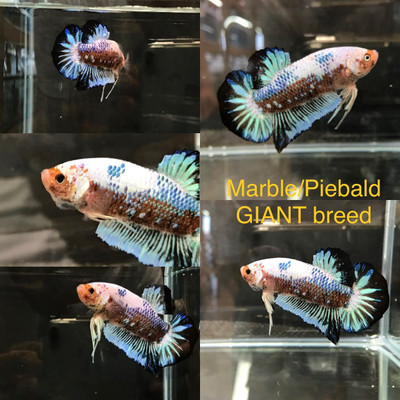The Enchanting Betta Fish: A Comprehensive Guide to Betta Splendens
Posted by Max Gandara on on 5th Mar 2024
Origins and Natural Habitat:
Betta fish hail from the tropical regions of Southeast Asia, including Thailand, Cambodia, Vietnam, and Laos. In their natural habitat, Betta splendens inhabit slow-moving waters, rice paddies, and shallow ponds. These environments are characterized by warm temperatures, typically ranging from 75°F to 82°F (24°C to 28°C), and often feature dense vegetation and mud.
Distinctive Features and Varieties:
Betta splendens are renowned for their striking physical attributes, making them a sought-after choice for aquarium enthusiasts. Key features include:
- Coloration: Bettas come in a mesmerizing array of colors, including vibrant reds, blues, greens, purples, and even iridescent shades. The brilliance of their colors is attributed to pigments and chromatophores in their skin.
- Fins: Bettas are distinguished by their elaborate fins, which can be long and flowing. The fins are categorized into different types, including the tail fin, dorsal fin, anal fin, and pelvic fins. Common tail types include veil tail, half-moon, crown tail, and delta tail.
- Labyrinth Organ: One of the most unique features of Betta fish is their labyrinth organ, allowing them to breathe atmospheric air. This adaptation enables them to survive in oxygen-deprived waters, such as stagnant puddles and rice paddies.
Care Requirements:
Ensuring the well-being of Betta fish involves providing them with a suitable environment and meeting their specific care requirements:
- Tank Size: While Betta fish are often kept in small bowls, it's advisable to provide them with a minimum tank size of 2.5 gallons. A larger tank, preferably 5 gallons or more, offers more stable water parameters and allows for better filtration.
- Water Parameters: Bettas thrive in slightly acidic to neutral water with a pH range of 6.5 to 7.5. The water temperature should be maintained between 76°F to 82°F (24°C to 28°C). Regular water changes are essential to prevent the buildup of toxins.
- Filtration and Aeration: A gentle filter and aeration system are crucial for maintaining water quality and oxygenating the tank. Bettas prefer still or slow-moving water, so choose a filter with adjustable flow settings.
- Tank Decor and Substrate: Provide hiding spots, live or silk plants, and soft substrates like gravel or sand. Bettas enjoy exploring their environment and resting on broad leaves or other surfaces.
- Compatible Tankmates: While Bettas are known for their solitary nature, some can coexist with compatible tankmates such as peaceful schooling fish, snails, or shrimp. However, caution should be exercised to prevent aggressive interactions.
Feeding:
Betta fish are carnivorous and thrive on a varied diet that includes high-quality betta pellets, live or frozen bloodworms, brine shrimp, and daphnia. Feed them small portions once or twice a day, ensuring they consume their food within a few minutes.
Health and Common Issues:
Monitoring the health of Betta fish is essential for preventing and addressing potential issues. Common health concerns include fin rot, ich, and constipation. Regular observation, water testing, and a balanced diet contribute to their overall well-being.
Breeding Betta Fish:
For those interested in breeding Betta fish, a separate breeding tank with appropriate nesting sites, conditioned parents, and proper water conditions is crucial. The process involves an elaborate courtship display, bubble nest construction, and careful management of the fry (baby Betta fish) after hatching.
Betta fish, with their stunning colors and charismatic personalities, have rightfully earned their place as cherished aquarium pets. By understanding and meeting their specific care requirements, enthusiasts can create thriving environments for these captivating creatures, allowing them to showcase their vibrant beauty and unique behaviors. Whether you are a novice aquarist or an experienced hobbyist, the Betta splendens is sure to bring joy and fascination to your aquatic endeavors.

